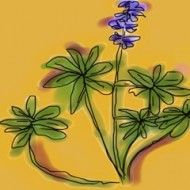Slide show at the Arboretum
Tomorrow, Thursday September 15th, I will be presenting a slide show in “Garden Talks with Lili Singer” at the Los Angeles County Arboretum and Botanic Garden in Arcadia. The subject: A year in a new garden, during which 9,000 square feet of lawn was removed to make way for a mixed native and food garden. The presentation will be followed by a field trip to the garden. Click here for details.
…
The Dry Garden: Vertical meadow
Jasmine Hawes and mother Ginny Hawes (background) kindly posed for scale in this summer's towering sunflower garden, planted as part of a conversion from lawn to a water efficient native garden.
There’s overdoing it, and there’s what I did. After sowing a pound of sunflower seeds last winter, eight months later, the phrase “height of summer” can now be taken literally. In lieu of a front hedge, I have sunflowers. One astounded woman even came to my door asking when and how to plant them. Neighbors call my home “the sunflower house.” Out back, my yard is a vertical meadow.
Click here to keep reading “The Dry Garden” in the Los Angeles Times on how wildflowers can serve as a succession crop when replacing lawn.
Click here to see what’s doing at the Theodore Payne Foundation for Wildflowers and Native Plants, and here for our regional treasure, the Rancho …
End of days and weeks
As we enter Native Plant Week in California and approach Earth Day world-wide, this advocate of native plants and appreciator of the Earth will observe them exactly the same way that I observe World Water Day. I won’t. Chronological gimmicks don’t work. Worthwhile goings on in April packaged up by others as part of Native Plant week are in this blog part of the normal run of Dry Garden Events.
…
The Dry Garden: Pacific coast irises
Pacific coast iris and blue-eyed grass. Photo: Rancho Santa Ana Botanic Garden
One of the most common questions during California’s wildflower season is: “Is it too late to plant?” If you’re working from seed, yes. The lupines, clarkia, poppies and sunflowers coming into bloom now germinated last fall. It is only by the capturing of residual autumn warmth and early winter rain that they put down roots needed for a vigorous spring bloom.
However, the window to plant spring wildflowers does remain open in April for our native Pacific coast irises. This window is kept jammed open partly by the nursery trade, which often doesn’t release the plants until March — not ideal, but possible because irises are perennials. Although they do produce seeds, they grow from rhizomes, or tubers, that produce annual sets of roots.
If we want newly bought irises to go in the ground this year, …
The Dry Garden: “Reimagining the California Lawn”
Maybe you want to remove your lawn. Maybe you want to reduce it to make way for flowers, food or a shade tree. Maybe you don’t know what you want. A new book, written by three of California’s most knowledgeable horticulturists, lays out options.
It would be disingenuous to treat Reimagining the California Lawn (Cachuma Press, 2011) like any other garden book. It’s not. The authors have close to rock star status in the Golden State, something they possessed even before the 2005 publication of their first book, California Native Plants for the Garden.
Carol Bornstein, now a Central California garden designer, was for many years director of horticulture of the Santa Barbara Botanic Garden. The heart-stoppingly beautiful meadow there is her work. In 1976, David Fross co-founded Native Sons Nursery in Arroyo Grande and has since been the Johnny Appleseed of dry gardening. For many years …
« go back — keep looking »

